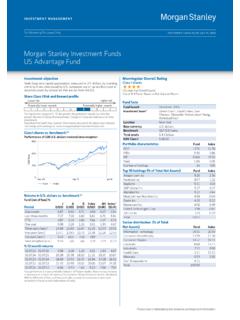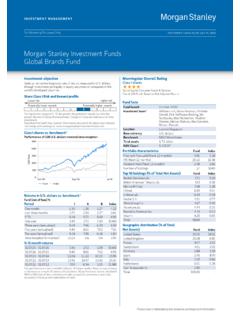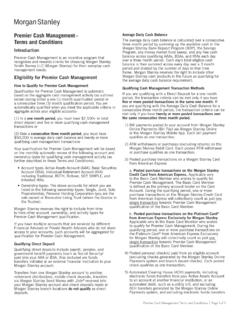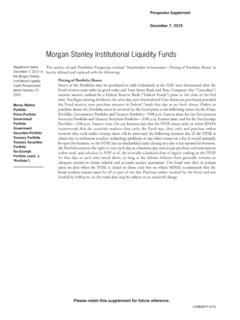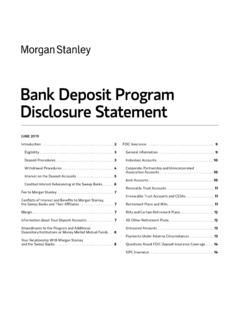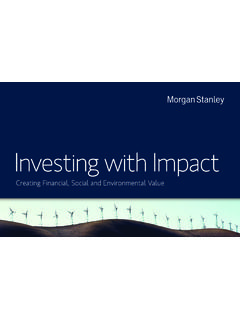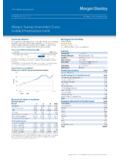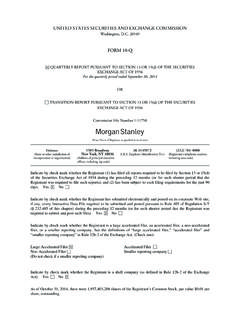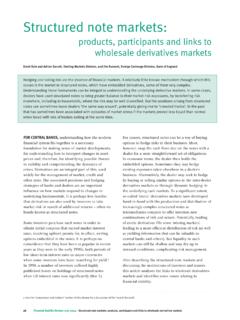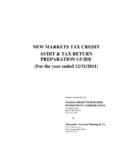Transcription of Introduction to Structured Investments - Morgan Stanley
1 Product resource april 2013 Introduction to Structured Investmentssummarytable of contentsJust as stocks and bonds serve as essential components at the foundation of a diversified financial portfolio, Structured Investments may be added to an investor s holdings to address a particular investment objective within an overall investment flexible and evolving segment of the capital markets, Structured Investments typically combine a debt security or certificate of deposit (CD) with exposure to other underlying asset classes (such as equities, commodities, currencies or interest rates) to create a way for investors to express a market view (bullish, bearish or market neutral), complement an investment objective (conservative, moderate or aggressive), hedge an existing position or gain exposure to a variety of underlying asset Financial Advisor can provide you with detailed information about specific Structured Investments and how these vehicles may help you accomplish your financial Anatomy of Structured Investments3 Structured investment Categories4 Overview of Market-Linked Notes, FDIC Insured Market-Linked Deposits and Partial Principal at Risk Securities5 Overview of Enhanced Yield Investments6 Overview of Leveraged Performance Investments7 Overview of Access Investments8 Structured Investments and Your Portfolio9 Additional Resources and Risk Considerations2 Morgan Stanley | 2013product resource / Introduction to Structured investmentsAnatomy of Structured Investments S tructured Investments usually combine a debt security with ex-posure linked to the performance of an underlying asset, such as equities.
2 Interest rates, commodities or curren-cies. In some instances, exposure can be linked to two or more underlying assets, which are often referred to as hybrid offerings or derivative Investments . Structured Investments are typically originated and offered by investment banks and come in a variety of forms, the most common being senior unse-cured notes of the issuer. They can also come in the form of CD bank deposits, and their principal (but not unrealized gains) is insured up to applicable limits by the Federal Deposit Insurance Corp. (FDIC), an independent agency of the investment mar-kets. The Morgan Stanley Structured Investments team distributes a wide range of Structured investment products that can be linked to a variety of asset classes as seen on table general, the key characteristics of a Structured investment are:Fixed Term. All Structured invest-ments have a specified maturity date or term, as short as three to six months or as long as 15 to 20 years.
3 Investors should consider the maturity of the offering based on their own view of the markets and their anticipated future income and liquidity Returns. Struc-tured investment returns are based on specific formulas that are tailored to a particular market outlook or market view. Investors know from the outset how the performance of the underlying asset will determine their potential return or potential loss, provided that the investment is held until maturity. If sold prior to maturity in the second-ary market, the value of the securities could be significantly less than the initial to Generate Outperfor-mance. Structured Investments can be designed to potentially generate returns in excess of a specific benchmark within a range of performance. Outperformance strategies, however, are subject to sig-nificant risk of loss of Risk. All payments on struc-tured investment products, including the payment of par at maturity (where provided for by the terms or the product), are subject to the issuer s credit Structured investment products may be Structured to pay at least par, or a percentage of par, at maturity.
4 However, many products do not guarantee the repayment of par and therefore expose investors to the potential loss of some or all of their principal. All these products are subject to the issuer s credit risk. In addition, selling Structured investment products prior to maturity may result in a see the risk factors in Ad-ditional Resources and Risk Consid-erations on page 9 of this ClassExamplesEquitiesA single stock, a basket of stocks, an exchange- traded fund or an indexInterest RatesLondon Interbank Offered Rate (LIBOR), constant maturity swap rates or an inflation indexCommoditiesMetals, grains, oil, a commodity basket or a commodity indexCurrenciesA single currency or a basket of currenciesTable 1morgan Stanley | 2013 3 Structured investment CategoriesM organ Stanley Structured Invest-ment products can be divided into five basic categories, each offering structural characteristics designed to help investors realize specific financial five major Structured investment strategies are.
5 N Market-Linked Notes and Market-Linked Depositsn Partial Principal at Risk Securitiesn Leveraged Performance Investmentsn Enhanced Yield Investmentsn Access InvestmentsRisk-Return SpectrumEnhanced Yield*Leveraged PerformanceBull PLUSSMB uffered PLUSSMBear PLUSSMP artial Principalat Risk SecuritiesMarket-Linked NotesMarket-Linked DepositsAccessMore aggressive, higher risk level and higher potential returnMore conservative, lower risk level and lower potential return* Enhanced Yield Structured Investments are often linked to a single stock, which increases risk in the underlying asset. However, some Enhanced Yield structures can pay par at maturity, which results in lower risk to the principal amount invested. Depending on the features of a particular offering, Enhanced Yield and Leveraged Performance offerings are often equally as aggressive, as compared to Partial Principal at Risk Securities, Market-Linked Deposits and Market-Linked Morgan Stanley | 2013product resource / Introduction to Structured investmentsM arket-linked notes provide inves-tors with the return of principal at maturity, subject to the credit risk of the issuer.
6 Depending on the structure of the investment , they may offer the opportunity to participate in gains generated from the underlying asset. Market-linked notes are typically is-sued in note form and investors will be subject to the credit risk of the issuer. Market-linked notes are not insured by the deposits provide investors with the return of princi-pal at maturity, subject to the credit risk of the issuer and FDIC insurance limits. Depending on the structure of the investment , they may offer the opportunity to participate in gains generated from the underlying asset. Market-linked deposits take the form of CDs, which are bank deposits, and their principal is insured up to ap-plicable limits by the principal at risk securities return between 90% and 99% of the initial principal investment at matu-rity, subject to the credit risk of the issuer. They may offer higher potential returns than market-linked notes, but there is a higher risk of nonpayment of principal at maturity.
7 Partial principal at risk securities are issued in note Partial Principal at Risk SecuritiesMarket-Linked NotesOverview of Market-Linked Notes, FDIC Insured Market-Linked Deposits and Partial Principal at Risk SecuritiesInitial InvestmentReturn at Maturity[90 99]% of the Initial investment plus the Performance Component (if any)Loss / Profit100$100$90 Performance Component (if any, and may be subject to a cap)Investors receive a minimum of 90% of their original investment , or stated another way, investors may lose up to 10% of their initial investment . Depending upon the actual offering, investors may receive a minimum of up to 99% of their original investment .$0 to $10 Initial InvestmentReturn at Maturity[90 99]% of the Initial investment plus the Performance Component (if any)Loss / Profit100$100$90 Performance Component (if any, and may be subject to a cap)Investors receive a minimum of 90% of their original investment , or stated another way, investors may lose up to 10% of their initial investment .
8 Depending upon the actual offering, investors may receive a minimum of up to 99% of their original investment .$0 to $10form and are not insured by the FDIC. Investors are subject to the credit risk of the notes, market-linked deposits and partial principal at risk securities generally do not pay interest. Morgan Stanley | 2013 5 Instead, they offer the potential for the investor to earn a supplemental payment at maturity based upon the performance of the underlying asset. They may also include a cap or other feature that limits the potential return at maturity. Alternatively, certain market-linked deposits, market-linked notes and partial principal at risk securities may allow for potential periodic pay-ments in lieu of providing the opportu-nity to receive a return in excess of par at Investments and par-tial principal at risk securities may be appropriate for investors who: are willing to forgo a fixed coupon and potentially have no return, or up to 10% loss in the case of partial prin-cipal at risk securities, in exchange for potentially higher returns through exposure to an underlying asset; have a less aggressive investment strategy or want to manage overall principal at risk; are looking to preserve their initial investment at maturity, with the po-tential for some capital appreciation.
9 An investor in partial principal at risk securities may only preserve between 90% and 99% of the initial investment at maturity; and are willing to take issuer credit Investments and partial principal at risk securities may not be appropriate for investors who: want to avoid exposure to the credit risk of issuers of Structured notes; want to receive interest or dividend payments; do not want their returns to be capped. Some, but not all, market-linked notes specify a maximum payment at maturity; are wary of the possibility of receiving below-market returns as compared with ordinary debt from the same issuer; or are looking for Investments with liquid secondary of Enhanced Yield InvestmentsE nhanced yield Investments encom-pass a variety of products that may provide current income derived from taking a view on an underlying asset. In exchange for the potential to earn above-market annualized yields, in-vestors may be exposed to the risk of a complete loss of yield Investments may be appropriate for investors who: are willing to risk the loss of some or all of their principal in return for an above-market periodic yield, which in some cases may be contingent and therefore is also at risk;Enhanced YieldInitial InvestmentReturn at Maturity(Final coupon, if any, plus a final payment amount that can vary from $0 to $100)Loss / Profit100$100 Final coupon (if any)Final coupon (if any)Periodic coupons (if any)Investors are exposed to a full loss of their original investment .
10 Depending upon the actual offering and subject to the specified conditions, investors, in limited circumstances, may receive their initial investment .$0 to $100$X$X$X$X$X have a neutral to moderately bullish view on the underlying asset; and are willing to forgo returns based on any appreciation of the underly-ing yield Investments may not be appropriate for investors who: want to avoid exposure to the credit risk of issuers of Structured Investments ; desire regular periodic payments; need a guaranteed payment at maturity; or want to participate in appreciation of the underlying Morgan Stanley | 2013product resource / Introduction to Structured investmentsOverview of Leveraged Performance InvestmentsLeveraged performance securities attempt to capture enhanced returns relative to an underlying asset s actual return, within a range of performance, and are typically subject to a cap. In exchange for the potential to achieve excess returns within the defi ned range, most leveraged performance securities expose the investor to a potential loss of some or their entire performance Investments may be appropriate for investors who: are interested in generating returns beyond those available in moderately rising or range-bound markets; can take on full or partial downside risk and are able to sustain a partial or total loss of principal; seek to diversify their portfolio by gaining exposure to a variety of under-lying asset classes; and are willing to accept an investment with a maximum payout at performance Investments may not be appropriate for investors who: want to avoid exposure to the credit risk of issuers of Structured Investments ; want to receive interest or dividend payments; are unwilling to accept a loss of any principal.
